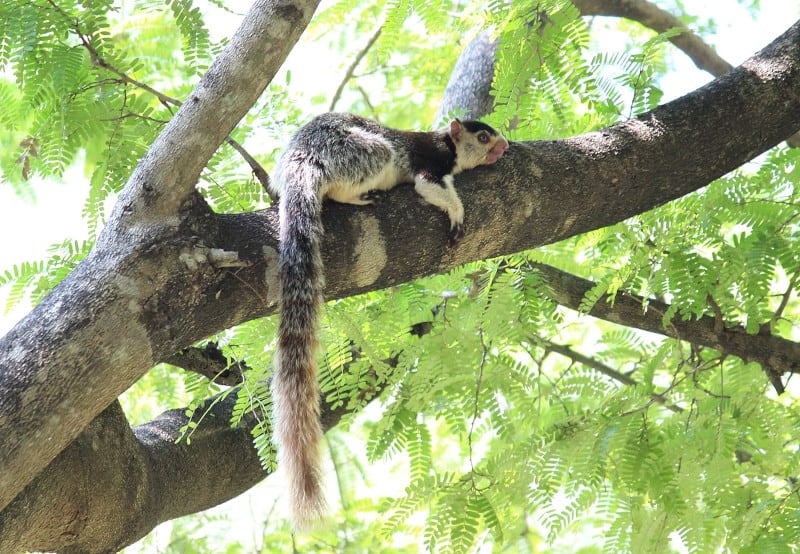
Grizzled Giant Squirrel Facts
- This astounding rodent most frequently goes by the descriptive common name of the Grizzled Giant Squirrel. That’s not its only generally used moniker, though. The intriguing animal also goes by the informative term of the Sri Lanka Giant Squirrel.
- Among members of the scientific community, however, it’s better known by its formal name. That’s the somewhat hard to pronounce term of Ratufa macroura. Regardless of which term one chooses to use, though, the animal represents a true marvel of Nature.
- It received its technical name due to the efforts of the respected Welsh naturalist, Thomas Pennant. He accomplished the first recorded recognition of the animal as a separate and distinct species. This scientifically noteworthy event took place in 1769.
- It distinguishes itself from its close relatives in an interesting manner. That’s true due to a pattern of behavior. All known related species balance themselves using their tails. This species, however, takes a different approach. It uses its hind feet for this purpose.
- Unfortunately, the Grizzled Giant Squirrel appears to have a relatively small population base. This also seems to be declining. The IUCN therefore presently lists the mammal as Near Threatened. That status appears on the organization’s published Red List.
- The remarkable creature faces several threats to its continued existence as a species. Like many species, most of these stem from the actions of man. They include habitat degradation and outright loss. Its greatest, though, likely comes from climate change.
Related Articles
Grizzled Giant Squirrel Physical Description
The aptly-named Grizzled Giant Squirrel quickly fascinates all those fortunate enough to encounter it. The animal does so for several reasons, as well. Although physical size isn’t the only one of these factors, its very name implies that this nevertheless ranks among them.
Although it does qualify as a relative giant of its kind, it’s actually the smallest of the so-called giant squirrels in its part of the globe. The animal also displays a moderate degree of the physiological trait of sexual dimorphism. In its case this manifests in terms on size.
More specifically, male of the species attain a somewhat greater overall average size. The difference remains slight, however. In general, individuals reach an average body length ranging from 10 -18 in (25 – 45 cm). Its tail, though, typically grows to the same length!
The weight remains quite light, and nearly the same among both genders. Like its many genetic cousins, it displays a generally slendere body shape. The lengthy tail also typically manifests a fluffy appearance. It also boasts small rounded ears, with slightly pointed tufts.
The Grizzled Giant Squirrel additionally evolved comparatively broad hands, evolved for gripping. Both these limbs and the legs further have relatively large, powerful claws. This marvelous variety of squirrel also evolved dark brown eyes, and possesses excellent vision.
The rodent additionally displays a striking pattern of colors. The common name actually derives from the appearance of the tail. This shows a combination of brownish-gray with white highlights. The rest of the body presents combinations of brown, red, gray, and black.
- Kingdom: Animalia
- Phylum: Chordata
- Class: Mammalia
- Order: Rodentia
- Family: Sciuridae
- Genus: Ratufa
- Species: R. macroura
Grizzled Giant Squirrel Distribution, Habitat, and Ecology
Regrettably, the stunning Grizzled Giant Squirrel inhabits a very restricted range. That zone of habitation does happen to fall within a region of the world well known for its marvels of flora and fauna, though. That’s because the animal lives in a tiny portion of southern Asia.
Its population remains extremely low, though. The majority of these individuals make their home in two provinces of Sri Lanka, and two states in southern India. Thankfully, a large percentage of its numbers appear in sanctuaries, such as the Chinnar Wildlife Sanctuary.
It lives an almost entirely arboreal existence. Among the canopy of its home, the animal’s extremely agile. They often leap as much as 19.7 ft (6 m) between trees. Individuals typically only descend to the ground to flee predators, combat males for territory, or pursue females.
Unlike many similar species, this animal is primarily active during the day. It also demonstrates decided preferences for type of forests it lives in. The creature appears almost exclusively in areas of tropical or subtropical forests. These almost must be relatively dry.
The Grizzled Giant Squirrel does follow the dietary pattern common to its kind, though. Due to that, it’s an almost entirely herbivorous species. Its principal diet consists of a wide variety of nuts, fruit, and bark. It does, however, consume small quantities of insects and bird eggs.
It’s also an opportunistic animal by nature. Most specimens make use of naturally occuring holes in tree trunks for shelter. Both these and the dense canopy provides shelter from its own predators. Though comparatively few, some larger species of bird prey upon it.
Species Sharing Its Range
Check out our other articles on 3 Incredibly Intriguing Iguanas, Santa Rosa Island Manzanita, Uluru, Philippine Cobra, Army Green Moth, Black Rain Frog, Australian Sea Lion
